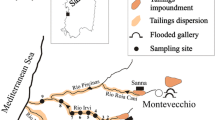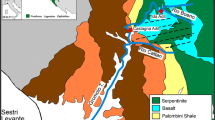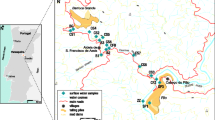Abstract
The biogeochemistry of Zn, Cd, Cu, Hg, and Fe in lakes and streams polluted by mine and smelter wastes emitted at Flin Flon, Canada, was investigated. In Schist Lake, a repository for both tailings-pond drainage and sewage, green algal blooms generated by nutrients from sewage promote entrapment of metals in sediments by (1) accumulation of metals from solution by algal seston, with preferential uptake of Zn, the most abundant metal, followed by sinking of the seston; and (2) production of H2S during decomposition of dead algae, resulting in sulfide precipitation. Metals are partially resolubilized from seston as it decomposes while sinking. Preferential retention of Cu by sinking seston and by mud promotes Cu enrichment in the mud but the Cu/Zn ratio of mud varies with the Cu/Zn ratio of surface water seston. In bottom muds, partitioning of a metal between sulfide and organic matter is strongly dependent on the stability of the metal sulfide as measured by its standard entropy, the proportion of sulfide-bound metal decreasing in the order Hg>Cd>Cu>Fe>Zn. When sulfide-rich muds were heated under helium, x-ray diffraction revealed abundant well-crystallized ZnS (sphalerite) containing Cd, Hg, and Fe; only poorly crystallized traces of the mineral were detected in unheated mud, however. Cu sulfide failed to crystallize, suggesting interference by sorbed impurities. Metals were concentrated in H2S-rich muds and extraction of muds with various solvents and by electrodialysis showed that sulfide was much more effective than organic matter in suppressing remobilization of metals. Remobilized Cu is probably bound to organic complexing agents. Some extractable complexing agents bind Cu preferentially with respect to Zn and Cd but others preferentially bind Zn and Cd; the complexes, being stable in the presence of free sulfide, may cause some release of metals from sulfide-rich muds in nature.
These results indicate that introduction of sewage together with heavy-metal effluents into settling ponds could be an effective and economic method for limiting heavy-metal pollution of natural waters.
Similar content being viewed by others
References
Andelman, J. B., 1973, Incidence, variability, and controlling factors for trace elements in natural, fresh waters,in Singer, P. C. (ed.), Trace metals and metal-organic interactions in natural waters: Ann Arbor, Mich., Ann Arbor Science, pp. 57–87.
Armstrong, F. A. J., 1975, Spectrophotometric determination of sulfide in water: Water Quality Parameters, ASTM STP 573, American Soc. for Testing and Materials, pp. 14–19.
Berner, R. A., 1964, Distribution and diagenesis of sulfur in some sediments from the Gulf of California: Mar. Geol., v. 1, pp. 117–140.
Beveridge, T. J., and R. G. E. Murray, 1976, Uptake and retention of metals by cell walls ofBacillus subtilis: J. Bacteriol. v. 127, pp. 1502–1518.
Craig, H., 1974, A scavenging model for trace elements in the deep sea: Earth Planetary Sci. Let., v. 23, pp. 149–159.
Crowe, J. M. E., 1973, A pollution survey of Schist Lake, 1969: Manitoba Dept. Mines, Resources, and Environmental Management, Research Branch, Report No. 73-21.
Deer, W. A., R. A. Howie, and J. Zussman, 1962, Rock-forming minerals, Vol. 5, Non-silicates: London, Longmans.
De Groot, A. J., and E. Allersma, 1975, Field observations on the transport of heavy metals in sediments,in Krenkel, P. A. (ed.), Heavy metals in the aquatic environment: New York, Oxford, Toronto, Sydney, Braunschweig, Pergamon Press, pp. 85–95.
Eichorn, G. L., 1956, Coordination compounds in natural products,in Bailar, J. C. (ed.), The chemistry of the coordination compounds: New York, Reinhold; London, Chapman and Hall, pp. 698–742.
Fagerström, T., and A. Jernelöv, 1971, Formation of methyl mercury from pure mercuric sulphide in aerobic organic sediment: Water Res., v. 5, pp. 121–122.
Fagerström, T., and A. Jernelöv, 1972, Some aspects of the quantitative ecology of mercury: Water Res., v. 6, pp. 1193–1202.
Feick, G., E. E. Johanson, and D. S. Yeaple, 1972, Control of mercury contamination in freshwater sediments: Environmental Protection Technology Series, Office of Research and Monitoring, U.S. Environmental Protection Agency (Washington, D.C.), Report No. EPA-R2-077.
Fogg, G. E., and D. F. Westlake, 1955, The importance of extracellular products of algae in freshwater: Proc. Intl. Assoc. Theoret. Appl. Limnol., v. 12, pp. 219–231.
Gardner, L. R., 1974, Organic versus inorganic trace metal complexes in sulfidic marine waters—some speculative calculations based on available stability constants: Geochim. Cosmochim. Acta, v. 38, pp. 1297–1302.
Gibbs, R. J., 1973, Mechanisms of trace metal transport in rivers: Science, v. 180, pp. 71–73.
Goldberg, E. D., 1965, Minor elements in sea water,in Riley, J. P., and G. Skirrow (eds.), Chemical ocenaography, vol. 1: London and New York, Academic Press, pp. 163–196.
Hallberg, R. O., 1972, Sedimentary sulfide mineral formation—an energy circuit system approach: Mineral. Deposita, v. 7, pp. 189–201.
Hutchinson, G. E., 1957, A treatise on limnology, vol. 1: New York, John Wiley and Sons; London, Chapman and Hall.
Irving, H., and R. J. P. Williams, 1953, The stability of transition-metal complexes: J. Chem. Soc., v. 1953, pp. 3192–3210.
Jellinek, F., 1968, Sulphides,in Nickless, G. (ed.), Inorganic sulphur chemistry: Amsterdam, London, New York, Elsevier, pp. 669–747.
Jernelöv, A., and H. Lann, 1973, Studies in Sweden on feasibility of some methods for restoration of mercury-contaminated bodies of water: Environ. Sci. Technol., v. 7, pp. 712–718.
Kemp, A. L. W., and A. Murdrochova, 1971, Electrodialysis: a method for extracting available nutrients in Great Lakes sediments: Intl. Assoc. Great Lakes Res., Proc. 14th Conf. Great Lakes Res., 1971, pp. 241–251.
Knauer, G. A., and J. H. Martin, 1973, Seasonal variations of cadmium, copper, manganese, lead, and zinc in water and phytoplankton it Monterey Bay, California: Limnol. Oceanogr., v. 18, pp. 597–604.
Knauss, H. J., and J. W. Porter, 1954, The adsorption of inorganic ions byChlorella pyrenoidosa: Plant Physiol., v. 29, pp. 229–234.
Krauskopf, K. B., 1956, Factors controlling the concentrations of thirteen rare metals in sea-water: Geochim. Cosmochim. Acta, v. 9, pp. 1–32B.
Lamar, W. L., 1968, Evaluation of organic color and iron in natural surface waters: Washington, D.C., U.S. Geol. Surv. Prof. Pap. 600-D. pp. D24–D29.
Leland, H. V., E. D. Copenhaver, and L. S. Corrill, 1974, Heavy metals and other trace elements: J. Water Poll. Contr. Fed., v. 46, pp. 1452–1476.
Loring, D. H., and R. T. T. Rantala, 1977, Geochemical analyses of marine sediments and suspended particulate matter: Environment Canada, Fisheries & Marine Service, Technical Report No. 700.
Manheim, F. T., 1961, A geochemical profile in the Baltic Sea: Geochim. Cosmochim. Acta, v. 25, pp. 52–70.
Manskaya, S. M., and T. V. Drozdova, 1968, Geochemistry of organic substances (transl. from Russian and edited by L. Shapiro and I. Breger): Oxford, London, Edinburgh, New York, Toronto, Sydney, Paris, Braunschweig.
Martin, J. H., 1970, The possible transport of trace metals via moulted copepod exoskeletons: Limnol. Oceanogr., v. 15, pp. 756–761.
McLaren, R. G., and D. V. Crawford, 1973, Studies on soil copper. I. The fractionation of copper in soils: J. Soil Sci., v. 24, pp. 172–181.
Mellor, D. P., and L. Maley, 1947, Stability constants of internal complexes: Nature, v. 159, p. 370.
Mellor, D. P., and L. Maley, 1948, Order of stability of metal complexes: Nature, v. 161, pp. 436–437.
Milanovich, F. P., D. W. Wilson, and Y. Yeh, 1975, Detoxifying effect of yellow substance onE. Coli in media containing copper: Nature, v. 253, pp. 460–461.
Miller, L. P., 1950, Formation of metal sulfides through the activities of sulfate-reducing bacteria: Contrib. Boyce Thompson Inst., v. 16, pp. 85–89.
Mills, K. C., 1974, Thermodynamic data for inorganic sulphides, selenides, and tellurides: London, Butterworths.
Morris, A. W., 1971, Trace metal variations in sea water of the Menai Straits caused by a bloom ofPhaeocystis: Nature, v. 233, pp. 427–428.
Nicholls, G. D., H. Curl, Jr., and V. T. Bowen, 1959, Spectrographic analyses of marine plankton: Limnol. Oceanogr., v. 4, pp. 472–478.
Nissenbaum, A., and D. J. Swaine, 1976, Organic matter-metal interactions in Recent sediments: the role of humic substances: Geochim. Cosmochim. Acta, v. 40, pp. 809–816.
O'Connor, J. T., and C. E. Renn, 1964, Soluble-adsorbed zinc equilibrium in natural waters: J. Am. Water Works Assoc., v. 56, pp. 1055–1061.
Pauli, F. W., 1975, Heavy metal humates and their behavior against hydrogen sulfide: Soil Sci., v. 119, pp. 98–105.
Payne, K., and W. F. Pickering, 1975, Influence of clay-solute interactions on aqueous copper ion levels: Water, Air, Soil Poll., v. 5, pp. 63–69.
Ramamoorthy, S., and B. R. Rust, 1976, Mercury sorption and desorption characteristics of some Ottawa River sediments: Can. J. Earth Sci., v. 13, pp. 530–536.
Rankama, K., and Th. G. Sahama, 1950, Geochemistry: Chicago and London, Univ. of Chicago Press.
Rashid, M. A., 1974, Absorption of metals on sedimentary and peat humic acids: Chem. Geol., v. 13, pp. 115–123.
Rashid, M. A., and J. D. Leonard, 1973, Modifications in the solubility and precipitation behavior of various metals as a result of their interaction with sedimentary humic acid: Chem. Geol., v. 11, pp. 89–97.
Reuter, J. H., and E. M. perdue, 1977, Importance of heavy metal-organic matter interactions in natural waters: Geochim. Cosmochim. Acta, v. 41, pp. 325–334.
Rickard, D. T., 1974, Kinetics and mechanism of the sulfidation of goethite: Am. J. Sci., v. 274, pp. 941–952.
Rowland, I. R., M. J. Davies, and P. Grasso, 1977, Volatilisation of methyl mercuric chloride by hydrogen sulfide: Nature, v. 265, pp. 718–719.
Rowley, W. J., 1975, A study of water pollution in the vicinity of Flin Flon, Manitoba. Part A: Water pollution sources: Environment Canada, Environmental Protection Service (Water Pollution Control Section), NW region, Surveillance Report EPS 5-NW-75-7.
Saxby, J. D., 1973, Diagenesis of metal-organic complexes in sediments: formation of metal sulphides from cystine complexes: Chem. Geol., v. 12, pp. 241–248.
Schnitzer, M., 1968, Reactions between organic matter and inorganic soil constituents: 9th Intl. Congr. Soil Sci., Trans., v. 1, pp. 635–644.
Schnitzer, M., 1969, Reactions between fulvic acid, a soil humic compound, and inorganic soil constituents: Soil Sci. Soc. Am. Proc., v. 33, pp. 75–81.
Scott, S. D., 1974, Experimental methods in sulfide synthesis,in Ribbe, P. H. (ed.), Sulfide mineralogy (Mineralogical Soc. America short course notes, Vol. 1): Washington, D. C., Mineralogical Soc. America, pp. 1-38.
Shapiro, J., 1964, Effect of yellow organic acids on iron and other metals in water: J. Am. Water Works Assoc., v. 56, pp. 1062–1082.
Shapiro, J., 1967, Yellow organic acids of lake water: differences in their composition and behaviour,in Golterman, H. L., and R. S. Clymo (eds.), Chemical environment in the aquatic habitat: Amsterdam, N. V. Noord-Hollandische Uitgevers, Maatschappij, pp. 202–216.
Sparling, A. B., 1968, Interactions between blue-green algae and heavy metals: D. Sc. dissertation, Sever Institut. of Technology, Washington Univ., St. Louis, Missouri.
Spencer, D. W., P. G. Brewer, and P. L. Sachs, 1972, Aspects of the distribution and trace element composition of suspended matter in the Black Sea: Geochim. Cosmochim. Acta, v. 36, pp. 71–86.
Stainton, M. P., M. J. Capel, and F. A. J. Armstrong, 1974, The chemical analysis of fresh water: Dept. of the Environment (Canada), Fisheries and Marine Service (Research and Development Directorate), Misc. Special Publ. No. 25.
Steeman-Nielsen, E., and S. Wium-Andersen, 1970, Copper ions as poison in the sea and in freshwater: Mar. Biol., v. 6, pp. 93–97.
Stevenson, F. J., 1977, Nature of divalent transition metal complexes of humic acids as revealed by a modified potentiometric titration method: Soil Sci., v. 123, pp. 10–17.
Szalay, A., 1964, Cation exchange properties of humic acids and their importance in the geochemical enrichment of UO ++2 and other cations: Geochim. Cosmochim. Acta, v. 28, pp. 1605–1614.
Temple, K. L., and N. W. Le Roux, 1964, Syngenesis of sulfide ores: sulfate-reducing bacteria and copper toxicity: Econ. Geol., v. 59, pp. 271–278.
Thomas, R. L., 1972, The distribution of mercury in the sediments of Lake Ontario: Can. J. Earth Sci., v. 9, pp. 636–651.
Timperley, M. H., and R. J. Allan, 1974, The formation and detection of metal dispersion halos in organic lake sediments: J. Geochem. Explor., v. 3, pp. 167–190.
Trudinger, P. A., I. B. Lambert, and G. W. Skyring, 1972, Biogenic sulfide ores: a feasibility study: Econ. Geol., v. 67, pp. 1114–1127.
Vosjan, J. H., and G. J. van der Hoek, 1972, A continuous culture ofDesulfovibrio on a medium containing mercury and copper ions: Netherlands J. Sea Res., v. 5, pp. 440–444.
Weiss, A., and G. C. Amstutz, 1966, Ion-exchange reactions on clay minerals and cation selective membrane properties as possible mechanisms of economic metal concentration: Mineral. Deposita, v. 1, pp. 60–66.
Zajic, J. E., 1969, Microbial biogeochemistry: New York and London, Academic Press.
Author information
Authors and Affiliations
Rights and permissions
About this article
Cite this article
Jackson, T.A. The biogeochemistry of heavy metals in polluted lakes and streams at Flin Flon, Canada, and a proposed method for limiting heavy-metal pollution of natural waters. Geo 2, 173–189 (1978). https://doi.org/10.1007/BF02430671
Issue Date:
DOI: https://doi.org/10.1007/BF02430671




